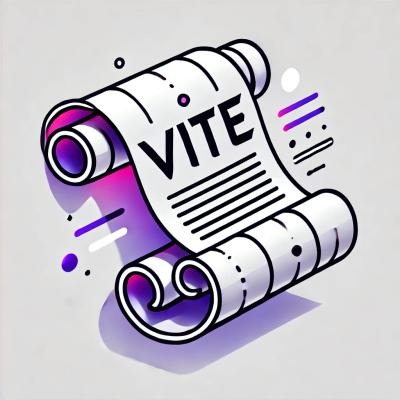
Security News
Vite Releases Technical Preview of Rolldown-Vite, a Rust-Based Bundler
Vite releases Rolldown-Vite, a Rust-based bundler preview offering faster builds and lower memory usage as a drop-in replacement for Vite.
This package is part of NDNts, Named Data Networking libraries for the modern web.
This package implements Type-Length-Value structure encoder and decoder as specified in NDN Packet Format v0.3. It has full support for TLV evolvability guidelines.
import { Encoder, Decoder, EvDecoder, NNI, StructBuilder, StructFieldNNI, StructFieldText } from "@ndn/tlv";
// other imports for examples
import { Name, TT as l3TT, StructFieldName } from "@ndn/packet";
import assert from "node:assert/strict";
The Encoder prepends encodable items to an internal ArrayBuffer.
It reallocates a larger buffer when necessary.
// Encode TLV object that implements EncodableObj interface:
let encoder = new Encoder();
encoder.encode(new Name("/A"));
// Look at the output:
assert.deepEqual(encoder.output, Uint8Array.of(0x07, 0x03, 0x08, 0x01, 0x41));
// Prepend a TLV structure with specified TLV-TYPE and TLV-VALUE:
encoder = new Encoder();
encoder.encode([0xB0, Uint8Array.of(0xC0, 0xC1)]);
assert.deepEqual(encoder.output, Uint8Array.of(0xB0, 0x02, 0xC0, 0xC1));
// Prepend a non-negative integer
encoder.encode(NNI(0x200110));
// We are using the same Encoder instance, so it gets prepended:
assert.deepEqual(encoder.output, Uint8Array.of(0x00, 0x20, 0x01, 0x10, 0xB0, 0x02, 0xC0, 0xC1));
// Put multiple encodable items in TLV-VALUE:
encoder = new Encoder();
encoder.encode([0xB0, Uint8Array.of(0xC0, 0xC1), new Name("/A")]);
assert.deepEqual(encoder.output,
Uint8Array.of(0xB0, 0x07, 0xC0, 0xC1, 0x07, 0x03, 0x08, 0x01, 0x41));
// `Encoder.encode()` is a shortcut for encoding one item and obtaining the output:
const wireB = Encoder.encode(new Name("/B"));
assert.deepEqual(wireB, Uint8Array.of(0x07, 0x03, 0x08, 0x01, 0x42));
The Decoder is a basic sequential decoder.
// Read Type-Length-Value manually:
let decoder = new Decoder(Uint8Array.of(0x08, 0x01, 0x41, 0xFF));
const { type, length, value } = decoder.read();
assert.equal(type, 0x08);
assert.equal(length, 1);
assert.deepEqual(value, Uint8Array.of(0x41));
// The remaining [0xFF] is still in the buffer.
assert.equal(decoder.eof, false);
// If you continue reading, you get an error due to incomplete TLV.
assert.throws(() => decoder.read());
// Decode into TLV object:
decoder = new Decoder(Uint8Array.of(0x07, 0x03, 0x08, 0x01, 0x41));
const nameA = decoder.decode(Name);
assert(nameA instanceof Name);
assert.equal(nameA.toString(), "/8=A");
// We have fully consumed the buffer.
assert.equal(decoder.eof, true);
// `Decoder.decode()` is a shortcut for decoding one item and checking for EOF.
const nameB = Decoder.decode(wireB, Name);
assert(nameB instanceof Name);
assert.equal(nameB.toString(), "/8=B");
// It throws if there's junk after the TLV.
assert.throws(() => Decoder.decode(Uint8Array.of(...wireB, 0xFF), Name));
The EvDecoder is a decoder that is aware of TLV evolvability guidelines.
It's used to implement decoding functions of TLV objects, such as Interest.decodeFrom.
Suppose we want to decode Adjacency type in NLSR's LSDB Dataset:
Adjacency = ADJACENCY-TYPE TLV-LENGTH
Name
Uri
Cost
Uri = URI-TYPE TLV-LENGTH *VCHAR
Cost = COST-TYPE TLV-LENGTH nonNegativeInteger
ADJACENCY-TYPE = 0x84
URI-TYPE = 0x8D
COST-TYPE = 0x8C
// Declare a class to represent this type.
class Adjacency {
public name = new Name();
public uri = "";
public cost = 0;
}
// Declare constants for TLV-TYPE numbers.
const TT = {
...l3TT,
Adjacency: 0x84,
Cost: 0x8C,
Uri: 0x8D,
} as const;
// Create the decoder.
const EVD = new EvDecoder<Adjacency>("Adjacency", TT.Adjacency)
.add(TT.Name, (t, { decoder }) => t.name = decoder.decode(Name), { required: true })
.add(TT.Uri, (t, { text }) => t.uri = text, { required: true })
.add(TT.Cost, (t, { nni }) => t.cost = nni, { required: true });
// Each rule declares a possible sub TLV.
// They are added in the order of expected appearance.
// The callback receives two arguments:
// (1) the target object we are decoding into, so that EVD instances are reusable;
// (2) a Decoder.Tlv structure, where we can selectively access just the TLV-VALUE, the whole TLV,
// the TLV-VALUE as a Decoder, the whole TLV as a Decoder, etc.
// Suppose we receive this encoded TLV:
const adjacencyWire = Uint8Array.of(
0x84, 0x0D,
0x07, 0x03, 0x08, 0x01, 0x41, // Name
0x8D, 0x01, 0x42, // Uri
0xF0, 0x00, // unrecognized non-critical TLV-TYPE, ignored
0x8C, 0x01, 0x80, // Cost
);
// We can decode it with the EVD.
const adjacency = EVD.decode(new Adjacency(), new Decoder(adjacencyWire));
assert.equal(adjacency.name.toString(), "/8=A");
assert.equal(adjacency.uri, "B");
assert.equal(adjacency.cost, 128);
The StructBuilder is a helper for defining a class that represents a TLV structure. It allows you to define the typing, constructor, encoder, and decoder, while writing each field only once.
// Create a StructBuilder and add the fields.
const buildAdj = new StructBuilder("Adjacency", TT.Adjacency)
.add(TT.Name, "name", StructFieldName, { required: true })
.add(TT.Uri, "uri", StructFieldText, { required: true })
.add(TT.Cost, "cost", StructFieldNNI, { required: true });
// You should call .add() on each successive return value, and save the last return value into the
// builder variable. This gradually builds up the typing of the TLV class.
// WRONG EXAMPLE:
// const builder = new StructBuilder();
// builder.add(...);
// builder.add(...);
// In the wrong example, typing information is not saved into the builder variable.
// Declare a class to represent the Adjacency type, inheriting from a base class supplied by the builder.
class Adj extends buildAdj.baseClass<Adj>() {}
// Assign the subclass to the builder (otherwise the decoding function will not work).
buildAdj.subclass = Adj;
// We can construct an instance and encode it.
const adj0 = new Adj();
adj0.name = new Name("/A");
adj0.uri = "B";
adj0.cost = 128;
const adj0Wire = Encoder.encode(adj0);
assert.deepEqual(adj0Wire, Uint8Array.of(
0x84, 0x0B,
0x07, 0x03, 0x08, 0x01, 0x41, // Name
0x8D, 0x01, 0x42, // Uri
0x8C, 0x01, 0x80, // Cost
));
// We can decode the wire encoding.
const adj1 = Decoder.decode(adjacencyWire, Adj);
assert.equal(adj1.name.toString(), "/8=A");
assert.equal(adj1.uri, "B");
assert.equal(adj1.cost, 128);
StructBuilder enables rapid development of TLV based structures, but is less flexible than writing code with Encoder, Decoder, and EvDecoder. Some limitations are:
Name with typed name components).SigInfo encoded as either ISigInfo or DSigInfo).FAQs
NDNts: TLV
The npm package @ndn/tlv receives a total of 13 weekly downloads. As such, @ndn/tlv popularity was classified as not popular.
We found that @ndn/tlv demonstrated a healthy version release cadence and project activity because the last version was released less than a year ago. It has 0 open source maintainers collaborating on the project.
Did you know?

Socket for GitHub automatically highlights issues in each pull request and monitors the health of all your open source dependencies. Discover the contents of your packages and block harmful activity before you install or update your dependencies.

Security News
Vite releases Rolldown-Vite, a Rust-based bundler preview offering faster builds and lower memory usage as a drop-in replacement for Vite.

Research
Security News
A malicious npm typosquat uses remote commands to silently delete entire project directories after a single mistyped install.

Research
Security News
Malicious PyPI package semantic-types steals Solana private keys via transitive dependency installs using monkey patching and blockchain exfiltration.